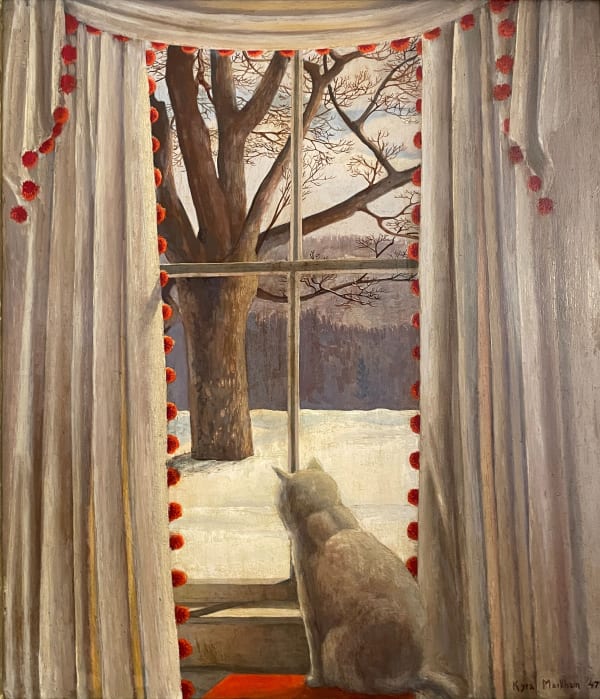Agnes Pelton is known better today for her western landscapes and her modernist works, but the Brooklyn-based painter had deep artistic roots on Long Island. This was especially true of her long relationship with the East End, which was the summer haunt of many prominent Brooklyn families during the late 19th and early 20th centuries including the Peltons. As an artist based in New York and the East End of Long Island, Pelton showed regularly at the Ardsley Studios and the MacDowell Club, where her works were favorably reviewed alongside her peers, including Charles Demuth, Marsden Hartley, Robert Henri, Leon Kroll and Jerome Myers. Beginning circa 1918, Pelton had a studio space in Greenport, on the North Fork of Long Island. Not long after, she became a fixture in the Hamptons, painting its landscape vistas and creating portraits of its residents while exhibiting her works in shows organized at the Memorial Hall in Southampton and at the Bridgehampton Community House. She became enamored with the old Hayground windmill, located halfway between Watermill and Bridgehampton, and by the early 1920s had built a small addition to the mill, housing a residence and studio space. Capitalizing on the solitude of her unusual abode, Pelton was thoroughly influenced by her surroundings; and yet her time living in the Hayground Windmill was perhaps the most socially driven period of her career. It was characterized by an outpour of portraiture—depictions of her friends and neighbors, and summer visitors to the Hamptons. One of her most prominent patrons was Samuel Parrish, the founder of Bridgehampton’s esteemed Parrish Art Museum. During a trip devoted to painting on Maui in the Hawaiian Islands in 1923, she noted as being from “Hay Crowned Windmill, Water Mill, Long Island…” Pelton would remain a regular fixture in the Hamptons even after her move to the American Southwest, and would return through the 1930s to exhibit and discuss her artwork to local audiences.
A painter of landscapes, portraits and floral subjects, Agnes Pelton was one of the few women artists whose work was included in the 1913 Armory Show. Although she initially worked in a representational manner, Pelton later became a pioneering figure in the development of American modernism.
Pelton was born in 1881 in Stuttgart, Germany, to American parents. She spent her girlhood years in France and Switzerland, where her artistic and musical pursuits were encouraged by her mother, Florence T. Pelton, an amateur artist. Pelton received her formal training at the Pratt Institute in Brooklyn, graduating in 1900. She spent the following year in Italy, visiting its museums and galleries in addition to painting on her own. Returning to America, she continued her studies, working under Arthur Wesley Dow at Ipswich, Massachusetts; William L. Lathrop at Old Lyme, Connecticut; and Hamilton E. Field at Ogunquit, Maine.
In 1913, two of Pelton's paintings were selected for inclusion in the International Exhibition of Modern Art, commonly known as the Armory Show. From that point on, Pelton's work was shown in major exhibitions throughout the United States. In 1915, she contributed pictures to a Woman's Suffrage Exhibition held at the Macbeth Galleries in New York. She also began exhibiting at Ogunquit, Maine, and participated in group shows at Knoedler Galleries in New York and at the Museum of New Mexico in Santa Fe. Pelton was a regular contributor to the exhibitions of the National Association of Women Artists from 1918 until 1932.
Up until the late 1920s, Pelton worked in a representational style, influenced by the tenets of Impressionism and Post-Impressionism. Her subject matter consisted, for the most part, of landscapes, portraits and flowers, executed in both oil and pastel. However in 1929, the Montross Gallery in New York featured a solo exhibition of Pelton's new work, entitled Abstractions. Taking her cue from such sources as cubism, surrealism and the abstractions of Wassily Kandinsky, Pelton abandoned figuration in favor of an approach which explored the emotional and spiritual effects of color. As the catalogue introduction stated, Pelton's color abstractions presented the viewer with "an inner realm, rather than an outer landscape ... color is like a voice, giving its message directly, without translation into presentment of recognizable colored objects".
Pelton settled in Cathedral City, California, in 1931. She continued to exhibit her work throughout the West, at the Santa Barbara Museum of Art, the Desert Inn Gallery in Palm Springs and the Crocker Art Gallery in Sacramento. Along with other non-objective painters, such as Emil Bisstram and Raymond Jonson, she helped found the Transcendental Painting Group in Santa Fe in 1938. Their main aesthetic precept, which revolved around the creation of forms which were "cosmic, universal and timeless", guided Pelton's art throughout the rest of her career. Among other motifs, the flowering foliage of the desert remained a constant source of inspiration for Pelton during her later years.
Agnes Pelton died in Cathedral City in March of 1961. Her work is represented in many public and private collections, such as San Diego Museum of Art, the Santa Barbara Museum and many others. Pelton was also included in the recent exhibition American Women Artists, 1830-1930, organized in celebration of the opening of the National Museum of Women in the Arts in Washington, D.C.






